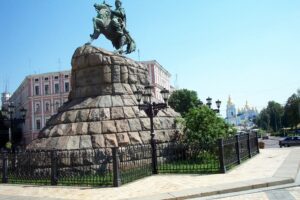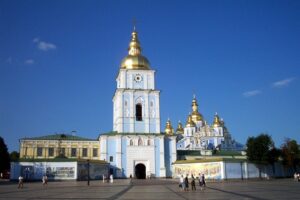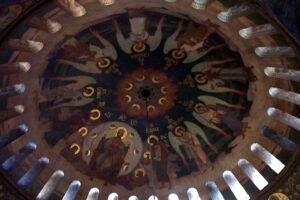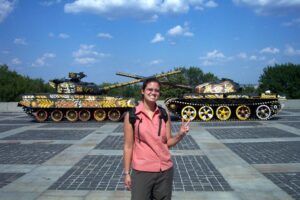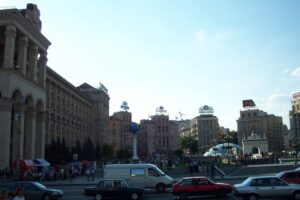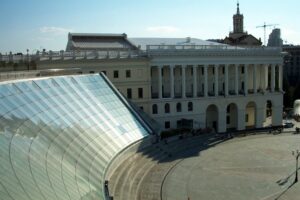Ukraine is full of unexpected surprises. When we did research to visit Kiev, we were flooded with travel agents who provided unsolicited information that finding a spouse in Ukraine was their specialty. We laughed and explained that we weren’t in search of lifelong partners but historical sights. Begrudgingly, we were offered our visa support letters and arrived in Kiev to find a vibrant, vivacious city full of beautiful people who are rejoicing in their new found independence. Oh, and the sights are spectacular too…don’t hesitate. Visit Ukraine and you’ll be pleasantly surprised.
Ukraine was one of the last remaining European countries for us to visit partly because it was difficult to obtain visa support for a spur of the moment trip there. Therefore, we decided that in May of 2003, we would plan a trip to Kiev and experience the beautiful city first hand. Obtaining visa support is easy if you book your lodging prior to arrival. We didn’t realize how popular Ukraine is among Western men who are in the quest for a wife because most of the websites we surfed for Ukrainian visa support targeted men who were meeting their fiancées for the first time or simply visiting Ukraine to meet several prospective future wives. The company we chose to use, Kiev Apartment Hotel Services, was very helpful in helping us obtain our visas and offered us a decent, affordable apartment in the Kiev city center. Upon arrival, we were met by a representative who brought us to our apartment and warned us to secure our valuables and not flaunt them on the city streets. He provided a brief city orientation tour to us before cutting us loose on our own. Since we only had a short four day weekend in the city, we wanted to maximize our short stay there.
Kiev is a beautiful city with marvelous hills and unique sightseeing. Its architectural landscape is unique and because of the large number of orthodox churches strewn across its skyline, it is sometimes called the gold-domed city. Our guidebook provided us with a brief synopsis on the history of Kiev which is recounted here. First settled in prehistoric times, Kiev became an East Slavic settlement during the 6th and 7th centuries. It soon developed into an important commercial center located on a major trade route. In 860 the city was taken over by Varangians (Vikings), who made it the center of the first significant East Slavic state, called Kievan Rus. In 988, during the reign of Volodymyr I (Vladimir I; also known as Saint Vladimir), the inhabitants of Kiev adopted the Greek Orthodox faith, and the city became the leading religious center in Kievan Rus. Unfortunately, Kiev’s exposed position made it especially vulnerable to attack and the Mongol armies, led by Batu Khan, sacked and destroyed the city in 1240. (See National Geographic’s February 1997 article detailing the Mongol Horde for more detail). Kiev remained under Mongol domination until the 1360s when it came under Lithuanian rule, followed by the Crimean Tatars, Poland and Russia. In the 18th century Kiev was heavily fortified, and in the 19th century it grew as a trade and industrial center. Kiev was under control of German troops during World War I and served as the scene for much of the fighting that occurred after the 1917 Russian Revolution. In 1934, Kiev replaced Kharkiv as the capital of Ukraine (which was then part of the Union of Soviet Socialist Republics). During World War II, Kiev was occupied by German Nazi forces and suffered great damage, losing as many as 200,000 of its inhabitants as well as many irreplaceable architectural and art treasures. After the war the city was reconstructed and resumed its place as one of the chief Soviet economic and cultural centers. Kiev hit headlines in April 1986, when the nuclear reactor at nearby Chernobyl exploded, but scientists generally agree that the city is now safe from radiation effects. Following the dissolution of the USSR in 1991, Kiev became the capital of independent Ukraine. The city is located on the Dnieper River (the third largest river in Europe) and offers some amazing views. The river is the dividing line in the city, with the old section’s ruins, ancient castles and fortifications lying on the right bank and the new quarters (post WW II) on the left bank. Kiev was an important medieval European religious center and is the home to several important religious buildings that survived intact throughout the centuries. Some of these famous buildings include the Cathedral of Saint Sophia (also known as the Hagia Sophia of Kiev; founded in the early 11th century but largely rebuilt in the 17th-18th century). Saint Sophia is the oldest cathedral in Ukraine and is famous for its amazing frescoes and mosaics. The large Perchersky, or Cave, Monastery (founded in the early 11th century) is world renowned for its ancient catacombs and is considered one of the most sacred edifices of the Ukrainian Orthodox Church. Other striking religious structures in Kiev include the baroque-style 18th-century Church of Saint Andrew and the late 19th-century Cathedral of Saint Vladimir. We planned on visiting all of these highlights as well as squeeze in a visit outside of Kiev to Pirogovo, the picturesque home to the outdoor museum of folk architecture and rural life. We considered hiring a local guide to give us a tour around Kiev since our time was so limited but after seeing how compact the city is (Kiev is definitely a walker’s paradise and should be explored on foot!), we decided against it.
Armed with our Ukraine guidebooks, we spent our first day touring the city’s main highlights. Our apartment was a five minute stroll to St. Sophia, which we made our first stop. Since it was late in the afternoon and we didn’t want to feel rushed, we decided to save our visit for another day and instead admired the baroque tower from Sophievskaya square. Next stop was a stroll across to St. Michael’s cathedral to admire the frescoes on the outside wall. After that, it was a leisurely walk on Andriyivsky Uzviz, a cobble-stoned street that connects Podil (in the upper town) and Kontraktova Plosha (Square). This was a really colorful street since it was packed full of numerous handicrafts stalls and artists selling wares such as embroidery, pottery or Russian Matryoshka dolls. St. Andrew’s church is a gorgeous green/gold orthodox church that is situated at the top of the hill and we stopped to admire its beauty. Nearby the church, a crowd was gathering around a statue of a man proposing to a woman. Everyone was fighting to take their picture next to this popular statue and we could only guess why since it wasn’t noted in our guidebooks. St. Andrew’s is an exquisitely beautiful 18th century Ukrainian baroque church and we eagerly snapped several photos of it from various angles. We continued down Andriyivsky Uzviz, which was really crowded with people buying/selling souvenirs or watching impromptu performances given by street side actors. Finally, we made our way down to Kontraktova Square (which is the oldest square in Kiev, dating back to the Kievan Rus period). Afterwards, we strolled back towards the Kiev Funicular for a ride back towards St. Michael’s. From there, we wandered down to Independence square and found hundreds of like-minded locals filling up the square. Most people clutched a bottle of brew and were downing significant quantities so we decided to join them. Beer from the nearby kiosks was not expensive and we proceeded to join in the fun for just a few dollars.
The next day we decided to visit the famous Kievo-Pecherska Lavra, which is a nine-hundred-year-old monastery. It is more commonly referred to as the Lavra Monastery, with the word “Lavra” considered an honorable title, bestowed only to monasteries of extra-size and special religious importance. Lavra monastery is an amazing complex since it houses two 11th Century cathedrals on its grounds, as well as its world famous underground catacombs, bell tower and museum collections. It is conveniently accessible via a short trolley ride from the center of town. We read that Lavra monastery was founded by several monks many centuries ago. These monks lived in caves that become known as the spiritual center of Ukraine. Even today, a visit to the complex is awe inspiring. It was super sunny when we visited and we were almost blinded by the light reflecting off the numerous golden domes sitting atop the complex’s many churches and belfries. Apparently, it is a miracle the monastery has survived throughout the years since time has attempted to ravage it. Amazingly, the monastery survived from numerous enemy attacks, devastating fires and other misfortunes relatively unscathed. Our favorite view was from the top of the belfry, overlooking Dormition Cathedral and the Dnieper River. Another cool experience was clambering through one of the catacombs. We bought candles at the entrance and descended deep into a maze link tunnel, stopping every so often to admire the frescoes painted on the walls as well as the intricately decorated tombs. The only drawback about the catacomb visit was that because the heat was on and many pilgrims were covered from head to toe in somber, black outfits, they stunk something furious. And while dealing with someone else’s bad BO is bad enough, having to deal with someone else’s bad BO when you are stuck in an unventilated, non air-circulating catacomb is so NOT cool. Needless to say, we were greatly relieved for a breath of fresh air once our visit ended! After our Lavra monastery visit, we still wanted more so we decided to stop by St. Micheal’s Cathedral. Originally built as early as 1108, it was demolished by the Russians in 1935 (the structure standing today looks brand new). The cathedral is located on a bluff overlooking the lower town. The main church, St. Michael of the Golden Domes, was the second largest church in medieval Kiev. We were astounded by the number of weddings that were ongoing throughout the city today. Apparently, it is tradition for couples to pose in their tuxedos and wedding dresses in front of Kiev’s most famous landmarks, with St. Michael’s being the most popular spot. We actually counted well over 20 limousines outside the complex, each one adorned with “his/her” gigantic wedding bands decorated on the limo’s roofs. It was a nice tradition that young couples were proud to continue and we enjoyed watching them parade around, fighting over the choice spots to have their photos taken. That night, we hung out around Independence Square. Hundreds of locals flooded the square and we were able to squeeze a space for two on a nearby ledge. Every time someone around us would finish drinking their beer and set their empty bottle down, bustling old ladies would whisk by and snatch the bottles to claim the redemption. Sometimes they had to duke it out when it was unclear who claimed the bottle first. Robby took pity and made eye contact with them first before handing over our empties so that no dispute could erupt. We spent a few hours enjoying the nightlife and people watching in Independence square before wandering back to our apartment.
Today we decided to take a break from the city and head out towards the museum of folk architecture and rural life. We hailed down a cab and negotiated our fare to Pirogovo. Once there, we wandered the 150 hectare grounds and peeked inside centuries-old homes. These wooden structures have been collected from various regions throughout Ukraine and most of them are original (some have been reconstructed). There were plenty of folk costumes, fabrics, embroidery, carpets, ceramics, metalwork, wood, glassware, musical instruments, paintings, and household articles on display. The museum is in a serene setting and we spent hours admiring different regional structures. Lunch consisted of lamb and chicken shashlik grilled at a traditional Ukrainian restaurant and served up with a wild berry dip…absolutely delicious! After exploring the open air museum grounds to our hearts content, we hopped a cab back into the city where we were pleased to find that a festival was going on along Kreschatik Street. This broad street stretches along the administrative parts of the city for over a kilometer and it was full of thousands of pedestrians, strutting their best stuff as if they were on a catwalk. A band was playing and the crowd was ecstatically waving Ukrainian flags and singing/dancing along. We were so caught up in the atmosphere we wanted to buy Ukrainian flags and learn the motherland song but we settled for joining the crowd drinking in the streets. Ukrainian pride was oozing everywhere and it was awesome to experience the positive vibes flowing through the crowd.
Our last day in Kiev! We had reserved this morning for finally visiting St. Sophia cathedral and were glad that we saved the best for last. The art and architecture of Kiev truly are world treasures, with the Cathedral of St. Sophia a must see for any visitor. St. Sophia is the oldest church in Kiev and it served as the site of the royal coronation ceremonies for all the princes of Kiev. It is also the home to some phenomenal mosaics and frescoes dating back to the 11th century. It is a majestic 13-domed church whose construction started in 1037 and lasted over a period of nine centuries! Inside the cathedral, we stared at the embellished frescoes, mosaic floors, sarcophagi, marble décor and were amazed that these relics survived for us to witness them today. In addition to the cathedral, the complex houses an 18th century baroque bell tower (four storied structure that is 76 meters tall), refectory, small Sofia church and monastery. The complex is extremely popular and we were glad that we were one of the first visitors admitted this morning because by the time we left, busloads of tourists were pouring in. We took a stroll back down Independence square one last time before sprinting back to our apartment, grabbing our bags and rushing off to the airport. We are really keen to revisit Ukraine so we can explore Odessa, Crimea and Yalta. Our overall impressions: If we had known that Kiev was this cool, we would have made it a priority earlier on! It is an awesome city although we’d recommend going in the summer unless you like to deal with a lot of snow. The only painful part was getting a visa prior to travel but there are plenty of agencies available to provide visa support so don’t procrastinate…visit this lovely country!

